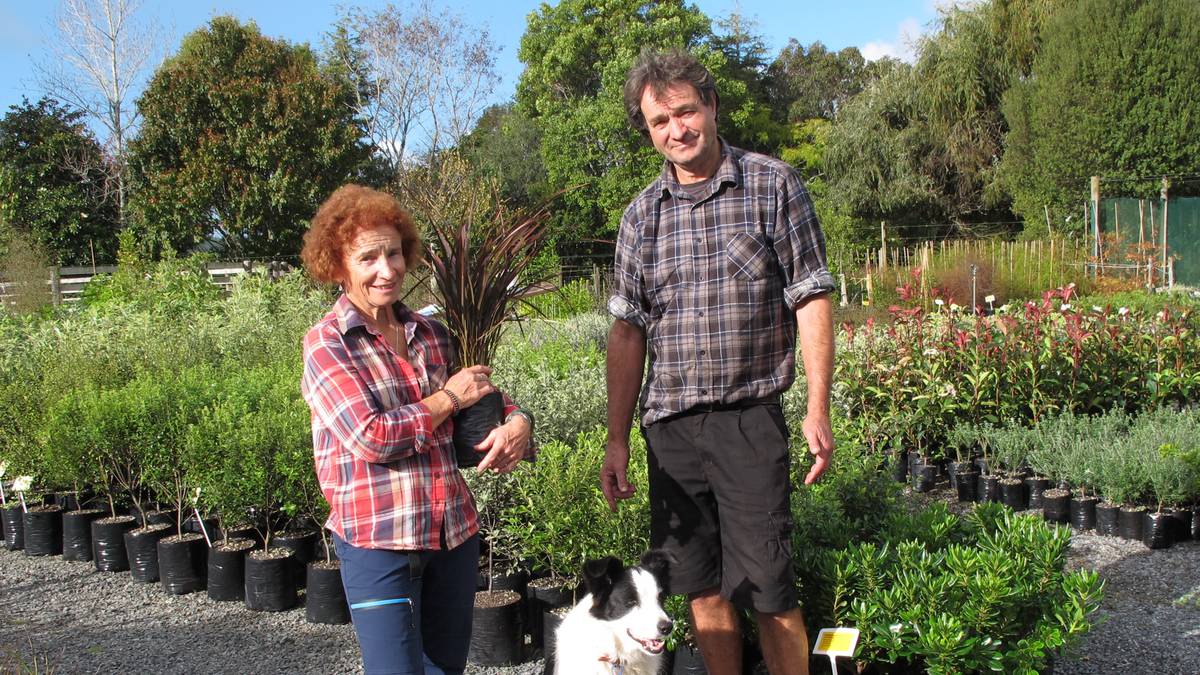Kerikeri Plant Production owners Julia Colgan and Tom Lindesay, with Xena the border collie, pictured in 2017 when they were allowed to reopen after the first case of Myrtle rust was found at their business. The couple have since sold the business. Photo / Peter De Graaf
Public Interest Journalism funded through NZ On Air
The former owner of a Northland plant nursery where myrtle rust was first discovered in Aotearoa says the future of pohutukawa is “a bit grim”.
Tom Lindesay was the co-owner of Kerikeri Plant Production in 2017 when the country’s first case of myrtle rust was discovered on a pohutukawa seedling.
It was revealed last week that the disease has been found on the oldest and largest pohutukawa tree in the country, at the East Cape settlement of Te Araroa.
Advertisement
It’s six years since the disease was discovered in May 2017.
Lindesay says he was not surprised at its spread.
“I thought it would end up like this. We just have to learn to live with it,” he says.
Myrtle rust is a fungal disease that affects new growth in Myrtaceae such as pohutukawa, manuka and ramarama.
Advertisement
/cloudfront-ap-southeast-2.images.arcpublishing.com/nzme/BCEFQJQCEVA5RESR2O7Z7O7ZFQ.jpg)
Experts say there is no known cure for myrtle rust.
For Lindesay, the future for species such as pohutukawa is “a bit grim”, as the disease targets juvenile native plants that are already challenging to grow.
“I don’t know what the answer is … because it’s really difficult to grow them.
“I’m a bit worried about it really.”
Once the seedlings are out of the nursery and planted, it is difficult to protect them from the wind-borne spores.
Lindesay suggests growing seedlings from cuttings as an alternative solution.
”[That’s] possibly the only way to get around it,” he says.
”So you bypass that …. juvenile stage of the seedlings which seem to be very prone to getting the disease”.
Biosecurity New Zealand led a response to control the spread of the disease in May 2017.
Over 600 sites of the pathogen were recorded at the time. There are now approximately 2900 sites reported since the response ended in 2018, after authorities realised the disease could not be contained.
Advertisement
The Kerikeri tree was two years old and five centimetres high when the disease was first discovered.
Due to the contagious nature of the disease, all Myrtaceae plants at Lindesay’s nursery were destroyed.
Their business was closed for a month.
“It was pretty devastating,” he says.
“We had to start again. We had to build up our breeding stock again.”
Lindesey said before myrtle rust arrived, MPI had alerted plant nurseries about its imminent arrival.
Advertisement
It had been found in the Kermadec Islands.
“It was just a matter of time before it was blown here.”
After owning the business for over 20 years, Lindesay and Julia Colgan sold Kerikeri Plant Production about 18 months ago.
The couple are now retired and volunteer in the propagating industry.
The Ministry for Primary Industries (MPI) encourages anyone who sees myrtle rust to report their findings through the iNaturalist app.





